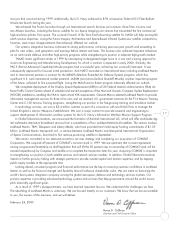Lockheed Martin 1999 Annual Report Download - page 21
Download and view the complete annual report
Please find page 21 of the 1999 Lockheed Martin annual report below. You can navigate through the pages in the report by either clicking on the pages listed below, or by using the keyword search tool below to find specific information within the annual report.
28
MANAGEMENT’S DISCUSSION AND ANALYSIS OF FINANCIAL CONDITION
AND RESULTS OF OPERATIONS
(Continued)
December 31, 1999
earnings of $1.3 billion. The 1999 reported amount includes
the combined after-tax effects of the nonrecurring and
unusual items discussed above of $162 million, including
$101 million related to the gain on the sale of the
Corporation’s remaining interest in L-3, $37 million associ-
ated with gains on the sale of surplus real estate, and a
$24 million net gain associated with the sale of non-core
businesses and investments and other portfolio shaping
actions. Nonrecurring and unusual items for 1999 also
include the effects of the Corporation’s adoption of
Statement of Position No. 98-5, “Reporting on the Costs
of Start-Up Activities,” effective January 1, 1999, which
resulted in the recognition of a cumulative effect adjustment
that reduced 1999 net earnings by $355 million. On a
combined basis, these nonrecurring and unusual items
decreased 1999 net earnings by $193 million, or $.51 per
diluted share. The after-tax effects of the nonrecurring and
unusual items in 1998 discussed above included $183 mil-
lion related to the charge for CalComp, $12 million related
to a gain on the initial public offering of L-3’s stock, $23
million associated with gains on the sale of surplus real
estate, and a gain of $12 million associated with the sale
of non-core businesses and investments and other portfolio
shaping actions. On a combined basis, these items decreased
1998 net earnings by $136 million, or $.36 per diluted
share. The after-tax effects of the nonrecurring and unusual
items in 1997 discussed above included the $311 million
tax-free gain resulting from the GE Transaction, $303 million
related to the charges recorded in the fourth quarter, $12
million associated with a gain on the sale of surplus real
estate, and a net gain of $46 million associated with other
portfolio shaping actions. On a combined basis, these
items increased 1997 net earnings by $66 million, or
$.15 per diluted share.
The Corporation reported diluted earnings (loss)
per share of $.99, $2.63, and $(1.56) for 1999, 1998,
and 1997, respectively. For the purposes of determining
the 1997 net loss applicable to common stock used in the
calculation of earnings per share, the excess fair value of
the assets transferred to GE over the carrying value of the
preferred stock (approximately $1.8 billion) was treated
as a deemed preferred stock dividend and deducted from
1997 net earnings. This deemed dividend had a signifi-
cant impact on the 1997 loss per share calculations, but
did not impact reported 1997 net earnings. The effect of
this deemed dividend was to reduce basic and diluted
earnings per share amounts by $4.93. If the nonrecurring
and unusual items described above were excluded from
the calculation of earnings per share, and, for 1997, if
the dilutive effects of preferred stock conversion and stock
options were factored into the diluted earnings per share
calculation, diluted earnings per share for 1999, 1998
and 1997 would have been $1.50, $2.99 and $2.87,
respectively.
Discussion of Business Segments
In September 1999, the Corporation announced the results
of the strategic and organizational review that began in
June 1999. As a result of this review, the Corporation has
implemented a new organizational structure, effective
October 1, 1999, that realigns its core lines of business
into four principal business segments. The four principal
business segments are Systems Integration, Space Systems,
Aeronautical Systems, and Technology Services. All other
activities of the Corporation fall within the Corporate and
Other segment. Prior period amounts have been adjusted
to conform with the new organizational structure.
The following table displays net sales for the Lockheed
Martin business segments for 1999, 1998 and 1997,
which correspond to the segment information presented in
Note 17 of the Notes to Consolidated Financial Statements:
(In millions)
1999 1998 1997
Net Sales
Systems Integration $10,954 $10,895 $10,853
Space Systems 5,825 7,039 7,931
Aeronautical Systems 5,499 5,459 5,319
Technology Services 2,261 1,935 1,989
Corporate and Other 991 938 1,977
$25,530 $26,266 $28,069
Operating profit (loss) by industry segment for 1999,
1998 and 1997, including the effects of the nonrecurring
and unusual items discussed previously, is displayed in the
























